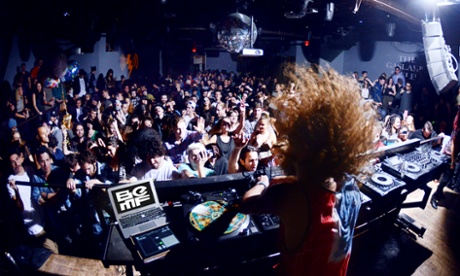
It’s Saturday night in a packed club in Brooklyn and there are smartphones everywhere. It’s the second night of the Brooklyn Electronic Music Festival (BEMF) and along with dancing, people post pictures on Instagram, tweet at the DJs and use Shazam to find out which tracks are playing.
Dance music or EDM is big business in the US. Festivals such as Electric Daisy have seen US audiences embrace dance music like never before, and now the best-paying DJ slots can be found at one of the mega hotels in Las Vegas such as Hakkasan – where DJs get anywhere between $200,000 and $300,000 – rather than their traditional home in Europe’s clubs. Now technology is helping to ignite the passion for dance music among Americans. Some of the most significant innovations happening at the moment, however, aren’t taking place in the production of the music itself, but how it’s enabling audiences to connect with the DJs.
BEMF, now in its 7th year, brought out a dedicated app this year, on which you could check set times, read up on the performers and even stream DJ sets if you couldn’t make it to the festival. In between sets by Huxley, Machinedrum, Eats Everything and The Gaslamp Killer at BEMF, festivalgoers could drop in on roundtable sessions about how to use technology to their creative advantage. Soundcloud, the music-sharing social platform, curated one of the stages.
BEMF co-founders Jennifer Lyon and Katie Longmyer have become increasingly aware that they’re now catering to an audience that expects a lot more from their events.
“Audiences are more discerning and more critical,” Lyon says. “They have less of a willingness to discover artists randomly on a lineup because they’re going to check them all out online.”
This act of digital due diligence can influence a festival’s booking process. No longer is the live event a destination for music discovery; that’s already happened on platforms such as Soundcloud, Mixcloud and Spotify. The club set has become about something else; there’s more of an emphasis on visuals and attention to how the space is used in the performance.
That’s not to say that audiences are necessarily expecting grand spectacles, but rather they’re looking for something they can’t get just by listening to an artist’s profile on Soundcloud. This isn’t, however, true across the whole scene. The New York-based promoters Mister Saturday Night, for example, have a strict no phones on the dance floor rule.
British artist Huxley, who played at BEMF, says that something more might just mean a feeling of being closer to a DJ, which can be achieved through technology. He used Kuvo as an example of this: an app he’d recently found that pushes live updates of the tracks a DJ plays during a set to a user’s phone.
“Obviously you interact with the crowd through the music you play and you hope that they react to it, but then there’s this kind of interaction – finding out about more information about the music or what a particular track is,” Huxley says.
Huxley says he’s also noticed a lot more people using Shazam, the app that ‘listens’ to a song and tells you what it’s called.
The last time Alexander Grosse – chief technology officer of Beatport, the largest online electronic music store – went clubbing he too saw this phenomenon. “The fans, the people who go dancing, tend to be very interested and very knowledgeable about technology so there’s a very natural connection there,” he says.
Lyon agrees: “The people working at tech companies are coming out to parties to see the DJs and feel a relationship with artists because they’re making their music with the technologies they’re working with everyday,” she says. The tech contingent encroaching on the dance music scene was most apparent at this year’s Burning Man festival. Silicon Valley elites reportedly descended on the dance music and arts festival and tried to outdo each other in the heat of the Nevada desert.
Todd Winkler teaches a course at Brown University on the history of dance music, from house music’s evolution out of the New York disco scene to the urban industrial influences on techno, and what this says about contemporary culture. He says: “This is really the history of inventions. And how those inventions created new music.”
Winkler explains that dance music’s trajectory can be charted against the emergence of a new technology or machine and the subsequent wave of culture that invention triggers. Winkler uses techno’s popularity in Germany as an example of when tech and techno combined: “The Berlin Wall comes down and techno hits right at that time and it just goes crazy.”
Dance music today wouldn’t be what it is without tech. It started with synthesizers and drum machines and has now moved on to laptops and tablets. The latest developments in tech – apps, streaming platforms and home editing software – have taken dance music’s potential far beyond production techniques. Tech is no longer just a way to make noise; now it’s deepening our understanding of a sound that’s starting to dominate our culture.

